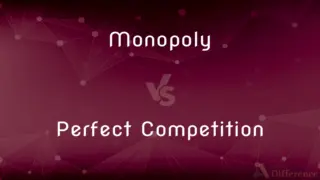Estuve vs. Estaba — What's the Difference?
Edited by Tayyaba Rehman — By Fiza Rafique — Published on December 28, 2023
"Estuve" means "I was" in a specific point in time; "Estaba" means "I was" in an ongoing or unspecified period. Both are past tense forms of "estar" in Spanish.

Difference Between Estuve and Estaba
Table of Contents
ADVERTISEMENT
Key Differences
Estuve and Estaba: "Estuve" is the first person singular preterite form of the verb "estar," denoting a completed action in the past. In contrast, "Estaba" is the imperfect form, suggesting an ongoing or habitual action in the past.
Usage: "Estuve" is often used to describe actions that occurred at a defined moment. For instance, "Estuve en la tienda ayer" means "I was at the store yesterday." "Estaba" describes situations with no specified beginning or end. "Estaba en la tienda cuando llamaste" translates to "I was at the store when you called."
Duration: The distinction between "Estuve" and "Estaba" often hinges on the duration of the action. "Estuve" implies a relatively short or specific duration, while "Estaba" indicates a longer, more indefinite timeframe.
Context: In narratives, "Estuve" might mark a significant event or turning point, while "Estaba" might set the scene or describe background events. For example, "Estuve enfermo la semana pasada" means "I was sick last week," suggesting a temporary illness. Meanwhile, "Estaba enfermo mientras crecía" means "I was sick while growing up," implying a prolonged condition.
Emphasis: While both terms refer to past events, "Estuve" emphasizes the action's completion, and "Estaba" focuses on the ongoing nature or context of the action.
ADVERTISEMENT
Comparison Chart
Tense
Preterite
Imperfect
Indication
Completed action in the past
Ongoing or habitual action in the past
Duration
Specific or short duration
Longer, more indefinite duration
Context
Marks significant events or turning points
Sets the scene or describes background events
Emphasis
Emphasizes the action's completion
Focuses on the ongoing nature or context
Compare with Definitions
Estuve
Indicates a specific past action.
Estuve trabajando hasta las 10 p.m.
Estaba
Reflects a state or condition in the past.
Estaba feliz con la decisión.
Estuve
Suggests a completed event.
Estuve enfermo, pero ahora estoy bien.
Estaba
Describes habitual or repeated actions in the past.
Estaba acostumbrado a correr todas las mañanas.
Estuve
First person singular preterite form of "estar."
Estuve en el concierto anoche.
Estaba
First person singular imperfect form of "estar."
Estaba en casa todo el día.
Estuve
Used for actions with clear start and end points.
Estuve leyendo ese libro la semana pasada.
Estaba
Used for background events in stories.
Estaba lloviendo cuando comenzó la historia.
Estuve
Marks a significant event in the past.
Estuve en España el año pasado.
Estaba
Indicates an ongoing past action.
Estaba escuchando música cuando llegaste.
Common Curiosities
Can Estuve and Estaba be used interchangeably?
No, they have distinct uses based on the nature and duration of the past action.
What does "Estuve aquí" mean?
It means "I was here," referring to a specific point in time.
Is "Estuve" used for actions with a clear start and end?
Yes, "Estuve" implies actions with definite boundaries in the past.
How is duration a factor in choosing between Estuve and Estaba?
"Estuve" implies shorter, specific durations; "Estaba" suggests longer, more indefinite periods.
What is the main difference between Estuve and Estaba?
"Estuve" indicates a completed past action; "Estaba" suggests an ongoing or habitual past action.
How would you translate "Estaba comiendo" to English?
"I was eating," indicating an action that was ongoing in the past.
Can "Estaba" describe a state or mood in the past?
Yes, like "Estaba feliz," meaning "I was happy."
Why use "Estaba" in storytelling?
"Estaba" sets the scene or describes background events in narratives.
How does Estuve emphasize completion?
"Estuve" denotes actions that have been fully completed in the past.
What's a typical scenario for using "Estaba"?
Describing what one was doing at a certain moment, like when someone called.
What verb does Estuve and Estaba derive from?
Both derive from the Spanish verb "estar."
Is "Estuve" always about the immediate past?
Not necessarily, but it refers to specific moments or events in the past.
Can "Estaba" reflect habits?
Yes, it can describe habitual actions or conditions in the past.
And "Estaba"?
It's in the imperfect tense.
In which tense is "Estuve"?
It's in the preterite tense.
Share Your Discovery

Previous Comparison
Finance Lease vs. Operating Lease
Next Comparison
Monopoly vs. Perfect CompetitionAuthor Spotlight
Written by
Fiza RafiqueFiza Rafique is a skilled content writer at AskDifference.com, where she meticulously refines and enhances written pieces. Drawing from her vast editorial expertise, Fiza ensures clarity, accuracy, and precision in every article. Passionate about language, she continually seeks to elevate the quality of content for readers worldwide.
Edited by
Tayyaba RehmanTayyaba Rehman is a distinguished writer, currently serving as a primary contributor to askdifference.com. As a researcher in semantics and etymology, Tayyaba's passion for the complexity of languages and their distinctions has found a perfect home on the platform. Tayyaba delves into the intricacies of language, distinguishing between commonly confused words and phrases, thereby providing clarity for readers worldwide.











































